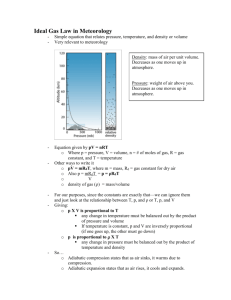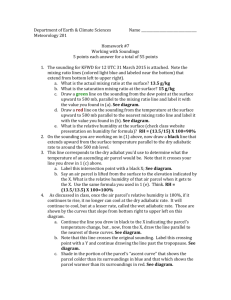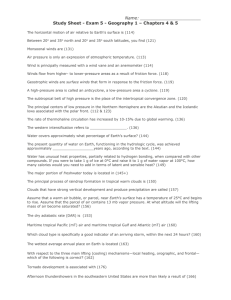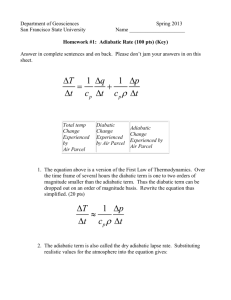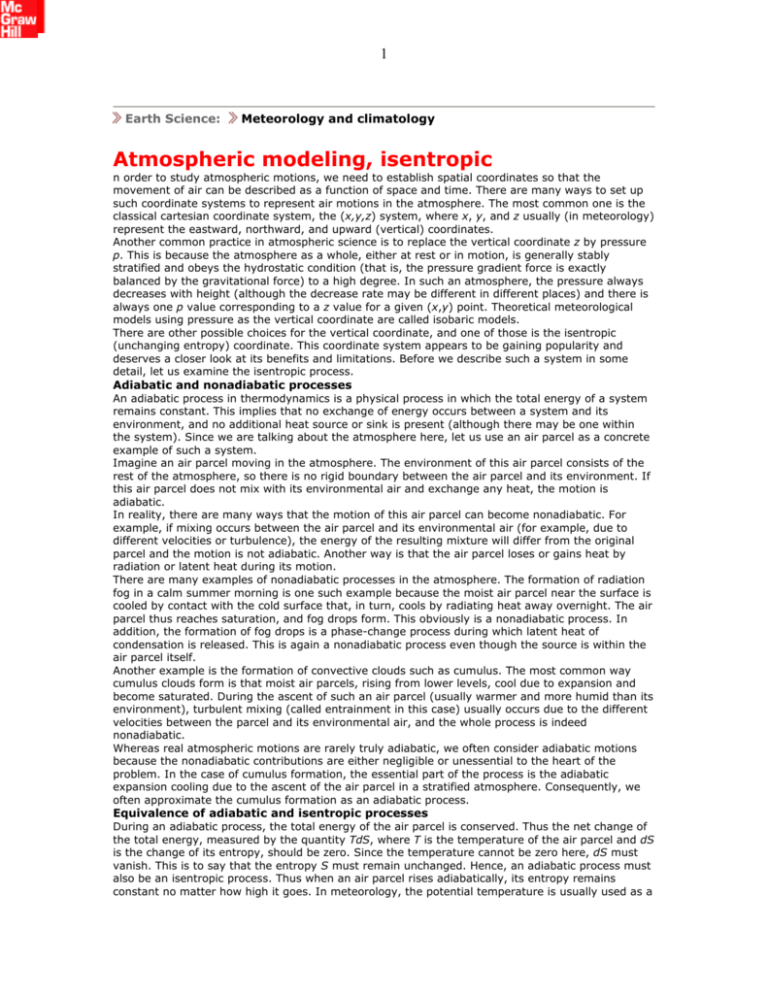
1
Earth Science:
Meteorology and climatology
Atmospheric modeling, isentropic
n order to study atmospheric motions, we need to establish spatial coordinates so that the
movement of air can be described as a function of space and time. There are many ways to set up
such coordinate systems to represent air motions in the atmosphere. The most common one is the
classical cartesian coordinate system, the (x,y,z) system, where x, y, and z usually (in meteorology)
represent the eastward, northward, and upward (vertical) coordinates.
Another common practice in atmospheric science is to replace the vertical coordinate z by pressure
p. This is because the atmosphere as a whole, either at rest or in motion, is generally stably
stratified and obeys the hydrostatic condition (that is, the pressure gradient force is exactly
balanced by the gravitational force) to a high degree. In such an atmosphere, the pressure always
decreases with height (although the decrease rate may be different in different places) and there is
always one p value corresponding to a z value for a given (x,y) point. Theoretical meteorological
models using pressure as the vertical coordinate are called isobaric models.
There are other possible choices for the vertical coordinate, and one of those is the isentropic
(unchanging entropy) coordinate. This coordinate system appears to be gaining popularity and
deserves a closer look at its benefits and limitations. Before we describe such a system in some
detail, let us examine the isentropic process.
Adiabatic and nonadiabatic processes
An adiabatic process in thermodynamics is a physical process in which the total energy of a system
remains constant. This implies that no exchange of energy occurs between a system and its
environment, and no additional heat source or sink is present (although there may be one within
the system). Since we are talking about the atmosphere here, let us use an air parcel as a concrete
example of such a system.
Imagine an air parcel moving in the atmosphere. The environment of this air parcel consists of the
rest of the atmosphere, so there is no rigid boundary between the air parcel and its environment. If
this air parcel does not mix with its environmental air and exchange any heat, the motion is
adiabatic.
In reality, there are many ways that the motion of this air parcel can become nonadiabatic. For
example, if mixing occurs between the air parcel and its environmental air (for example, due to
different velocities or turbulence), the energy of the resulting mixture will differ from the original
parcel and the motion is not adiabatic. Another way is that the air parcel loses or gains heat by
radiation or latent heat during its motion.
There are many examples of nonadiabatic processes in the atmosphere. The formation of radiation
fog in a calm summer morning is one such example because the moist air parcel near the surface is
cooled by contact with the cold surface that, in turn, cools by radiating heat away overnight. The air
parcel thus reaches saturation, and fog drops form. This obviously is a nonadiabatic process. In
addition, the formation of fog drops is a phase-change process during which latent heat of
condensation is released. This is again a nonadiabatic process even though the source is within the
air parcel itself.
Another example is the formation of convective clouds such as cumulus. The most common way
cumulus clouds form is that moist air parcels, rising from lower levels, cool due to expansion and
become saturated. During the ascent of such an air parcel (usually warmer and more humid than its
environment), turbulent mixing (called entrainment in this case) usually occurs due to the different
velocities between the parcel and its environmental air, and the whole process is indeed
nonadiabatic.
Whereas real atmospheric motions are rarely truly adiabatic, we often consider adiabatic motions
because the nonadiabatic contributions are either negligible or unessential to the heart of the
problem. In the case of cumulus formation, the essential part of the process is the adiabatic
expansion cooling due to the ascent of the air parcel in a stratified atmosphere. Consequently, we
often approximate the cumulus formation as an adiabatic process.
Equivalence of adiabatic and isentropic processes
During an adiabatic process, the total energy of the air parcel is conserved. Thus the net change of
the total energy, measured by the quantity TdS, where T is the temperature of the air parcel and dS
is the change of its entropy, should be zero. Since the temperature cannot be zero here, dS must
vanish. This is to say that the entropy S must remain unchanged. Hence, an adiabatic process must
also be an isentropic process. Thus when an air parcel rises adiabatically, its entropy remains
constant no matter how high it goes. In meteorology, the potential temperature is usually used as a
2
surrogate for entropy. Therefore, if the potential temperature of an air parcel stays the same after
the air parcel has moved from one place to the other, we know it has performed an adiabatic
motion.
Representing atmospheric motions in isentropic coordinates
Since the large-scale stratification of the atmosphere is stable, it is possible to use potential
temperature as the vertical coordinate, whereas the horizontal coordinates can be the regular (x,y)
coordinates as mentioned before. In a stably stratified atmosphere, the potential temperature varies
monotonically with height z. At any given z, there is only one corresponding potential temperature
value (theta), and hence there is no ambiguity. We shall see later that this is not so when the
stratification is unstable.
In a coordinate system using as the vertical axis, the interpretation of atmospheric motions is, of
course, different from that in cartesian coordinates. If an air parcel moves along a constant surface
(an isentropic surface), it is performing an adiabatic motion. On the other hand, if an air parcel
moves from an isentropic surface 1 to another isentropic surface 2 this parcel must have gone
through some nonadiabatic, or diabatic, processes. This implies that the air parcel has either gained
or lost energy. Thus by merely examining the changes in the vertical coordinate, we can discern the
energy state of the air parcel and possibly even identify the process that is responsible for such
changes. This is a great benefit in terms of analysis in atmospheric dynamics, a benefit not easily
realized in other coordinate systems.
Example of atmospheric convection in isentropic coordinates
Figure 1 represents a convective storm, using the results of a cloud model simulation of an actual
storm. Figure 1a shows a snapshot of the distribution of relative humidity in the central east-west
cross section of the simulated storm in regular cartesian (x,z) coordinates. Figure 1b shows the
same cross section but in isentropic coordinates. Compared to the cartesian coordinates, the
representation in isentropic coordinates exaggerates the upper portion of the system and hence is
better in resolving upper-atmospheric processes.
Fig. 1 Profile of relative humidity with respect to ice (RHi) in the central east-west cross section of a
simulated storm using a 3D cloud model (see P. K. Wang, 2003). (a) Profile in cartesian x-z coordinates.
White contour lines indicate the potential temperatures. (b) Same profile but in x- coordinates. White
contour lines indicate the height in kilometers.
3
There are also disadvantages in an isentropic coordinate system. In an unstably stratified
atmosphere, the isentropic surfaces may intersect each other, resulting in two or more values of
corresponding to a certain z (and vice versa) and in the vertical coordinate becoming ill-defined. The
other difficulty is that the lower boundary (that is, the earth surface in most cases) usually does not
conform to an isentropic surface, making the analysis complicated there.
Hybrid isentropic coordinate models
In order to alleviate the complication at the lower boundary (which is a problem not just to the
isentropic representation but to isobaric representation as well), hybrid models, which are based on
some kind of mixture vertical coordinates, have been developed. The most common of these is
probably the hybrid sigma-isentropic coordinate model, in which the lower part of the vertical
coordinate is the terrain-following coordinates while the upper part is the isentropic coordinate.
Naturally, the two vertical coordinates have to merge somewhere in the middle. One such hybrid
model is the hybrid - model developed by D. R. Johnson and coworkers. Figure 2 shows an
example of the cross sections of hybrid models.
4
Fig. 2 Schematic of meridional cross sections along 104°E for August 5, 1981. The broken lines
represent potential temperature in each panel. (a) Solid lines represent scaled sigma model surfaces. (b)
Solid lines represent - model surfaces. (Courtesy of D. R. Johnson)
Hybrid models have been increasingly popular, especially for studying global climate and transport
processes. This is mainly because of the quasiadiabatic nature of large-scale motions in the
atmosphere, especially when long-range material transport is concerned. Such transports tend to
move along isentropic rather than quasihorizontal surfaces, and three-dimensional advection
becomes quasi-two-dimensional, resulting in greatly reduced computational errors. The coordinate
used near the surface helps resolve the problem of a pure isentropic coordinate. There are also
some other advantages.
But there are also limitations of hybrid models. For one, a hybrid coordinate does not preserve
adiabatic flow in the boundary layer because it is not isentropic. In addition, the blending of the
coordinate and coordinate, if not done properly, may introduce spurious mass, momentum, or
energy sources. Modelers will have to weight advantages versus the limitations to suit their
purposes.
See also: Adiabatic process; Coordinate systems; Entropy; Isentropic process; Isentropic surfaces;
Isobaric process; Meteorology; Thermodynamic processes
Pao K. Wang
How to cite this article
Suggested citation for this article:
Pao K. Wang, "Atmospheric modeling, isentropic", in AccessScience@McGraw-Hill,
http://www.accessscience.com, DOI 10.1036/1097-8542.YB050180, last modified: June 23, 2005.
For Further Study
Topic Page:
Earth Science:
Bibliography
Meteorology and climatology
D. R. Johnson et al., A comparison of simulated precipitation by hybrid isentropic-sigma and sigma models,
Mon. Weath. Rev., 121:2088-2114, 1993
L. W. Uccellini, D. R. Johnson, and R. E. Schlesinger, An isentropic and sigma coordinate hybrid numerical
model: Model development and some initial tests, ,J. Atm. Sci., 36:390-414, 1979
P. K. Wang, Moisture plumes above thunder-storm anvils and their contributions to cross tropo-pause
transport of water vapor in midlatitudes, J. Geophys. Res., 108(D6):4194, 2003
(doi:10.1029/2003JD002581)
Additional Readings
Isentropic Analysis and Modeling
Customer Privacy Notice
Copyright ©2001-2003 The McGraw-Hill Companies. All rights reserved. Any use is
subject to the Terms of Use and Notice. Additional credits and copyright information. For
further information about this site contact AccessScience@romnet.com. Last modified:
5
Sep 30, 2003.


